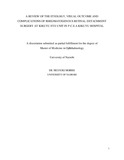| dc.contributor.author | Musyoki, Morris | |
| dc.date.accessioned | 2013-10-25T12:12:58Z | |
| dc.date.available | 2013-10-25T12:12:58Z | |
| dc.date.issued | 2013 | |
| dc.identifier.citation | Musyoki Morris (2013) A Review Of The Etiology, Visual Outcome And Complications Of Rhegmatogenous Retinal Detachment Surgery At Kikuyu Eye Unit In P.C.E.A Kikuyu Hospital. A dissertation submitted as partial fulfillment for the degree of Master of Medicine in Ophthalmology University of Nairobi. | en |
| dc.identifier.uri | http://erepository.uonbi.ac.ke:8080/xmlui/handle/11295/57905 | |
| dc.description.abstract | Introduction: Rhegmatogenous Retinal detachment is a treatable cause of blindness. The number of general ophthalmologists trained and working in eye clinics widely spread in Kenya has increased over time leading to early diagnosis and referral of rhegmatogenous retinal detachment cases to centers with vitreoretinal specialists. In view of this there is need to establish etiology of rhegmatogenous retinal detachment, currently used interventions, their outcome and complications arising from such interventions.
Aim: To review rhegmatogenous retinal detachment surgeries done at Kikuyu Eye Unit from 2007 to 2011.
Methods: A retrospective case series of 184 rhegmatogenous retinal detachment cases that underwent vitreoretinal surgeries at the Kikuyu Eye Unit in Kenya from January 2007 to December 2011 was undertaken. Data was analysed and presented in tables and graphs.
Main Outcome Measures: Best corrected visual acuity at 6-months postoperative and complications of surgery.
Results: One hundred and eighty-four (184) cases were analysed. Retinal break was the commonest etiology for rhegmatogenous retinal detachment (34.2%).Pars plana vitrectomy was the main intervention performed at 69%.Those eyes that had combined Pars plana vitrectomy and scleral buckle had better post-operative visual acuity outcome (p<0.009).Post operative visual outcome was better for patients who had better preoperative visual acuity and got early surgery. Vitreous hemorrhage at 4.1% was the commonest intraoperative complication; increased intraocular pressure at 50% was commonest early postoperative complication; and re-detachments at 18.9% and cataracts at 18.1% were the commonest late postoperative complications.
Conclusions: Retinal break, previous intraocular (cataract) surgery and non-surgical trauma were among the leading causes of rhegmatogenous retinal detachment identified. Pars plana vitrectomy with Endolaser was the most frequent intervention performed. This study demonstrated that early surgery leads to good visual outcome for rhegmatogenous retinal detachments. High intraocular pressure, vitreous hemorrhage, cataract and redetachment were common complications associated with vitreoretinal surgical interventions. | en |
| dc.language.iso | en | en |
| dc.publisher | University of Nairobi | en |
| dc.subject | Rhegmatogenous retinal detachment | en |
| dc.subject | pars plana vitrectomy | en |
| dc.subject | visual outcome | en |
| dc.subject | complications | en |
| dc.title | A review of the etiology, visual outcome and complications of rhegmatogenous retinal detachment surgery at Kikuyu eye unit in P.C.E.A Kikuyu hospital | en |
| dc.type | Thesis | en |
| dc.description.department | a
Department of Psychiatry, University of Nairobi, ; bDepartment of Mental Health, School of Medicine,
Moi University, Eldoret, Kenya | |
| local.publisher | School of Medicine | en |

